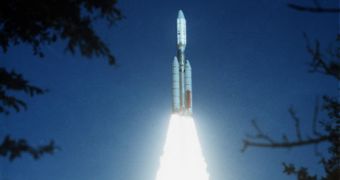NASA officials announced that the Voyager 2 spacecraft has just turned 35 yesterday. The satellite was launched into space aboard a Titan IIIE delivery system from the Cape Canaveral Air Force Station's (CCAFS) SLC-41, in Florida, on August 20, 1977.
This is the American space agency's longest-lived mission ever, and the first to zoom past Jupiter, Saturn, Uranus and Neptune during the same flight. Currently, it is heading out of the solar system, with the ultimate goal of making its way into interstellar space.
Even after several decades, both Voyager 2 and Voyager 1 – launched on September 5, 1977 – are operating within acceptable parameters and traveling away from the Sun at a great speed. The vehicles are powered by 3 Multihundred-Watt radioisotope thermoelectric generators (MHW RTG).
During all this time, scientists at the NASA Jet Propulsion Laboratory (JPL) in Pasadena, California, have been monitoring Voyager 2's signals. Over the past couple of years or so, things have gotten more interesting, since the spacecraft is approaching the actual edge of the solar system.
There is no clear boundary between the Sun's sphere of influence and interstellar space. The heliosheath is determined by solar winds pushing outwards from the star. Astronomers believe Voyager 2 is currently flying through an area where solar wind pressure is slowly being overcome.
Since August 13, Voyager 2 is the longest-lived NASA mission, having surpassed Pioneer 6's outstanding, 12,758-day record. The latter was launched on December 16, 1965, and sent its last transmission back home through the NASA Deep Space Network on December 8, 2000.
“Even 35 years on, our rugged Voyager spacecraft are poised to make new discoveries as we eagerly await the signs that we've entered interstellar space,” California Institute of Technology Voyager project scientist Ed Stone says. Caltech manages JPL for the NASA Science Mission Directorate.
“Voyager results turned Jupiter and Saturn into full, tumultuous worlds, their moons from faint dots into distinctive places, and gave us our first glimpses of Uranus and Neptune up-close,” he adds.
“We can't wait for Voyager to turn our models of the space beyond our sun into the first observations from interstellar space,” Stone goes on to say. He explains that the spacecraft is currently 9 billion miles (15 billion kilometers) away from the Sun, heading south.
“We continue to listen to Voyager 1 and 2 nearly every day. The two spacecraft are in great shape for having flown through Jupiter's dangerous radiation environment and having to endure the chill of being so far away from our Sun,” JPL Voyager Project Manager Suzanne Dodd concludes.

 14 DAY TRIAL //
14 DAY TRIAL //